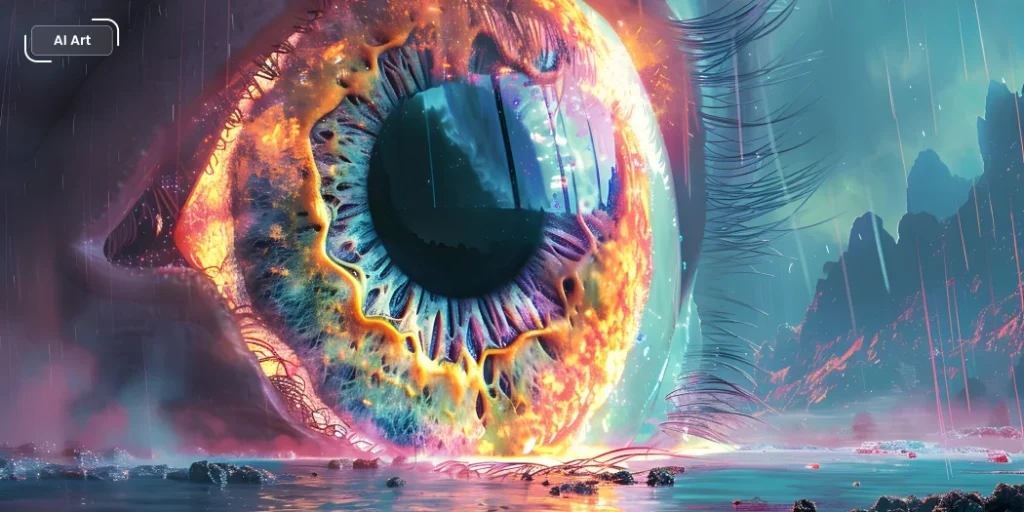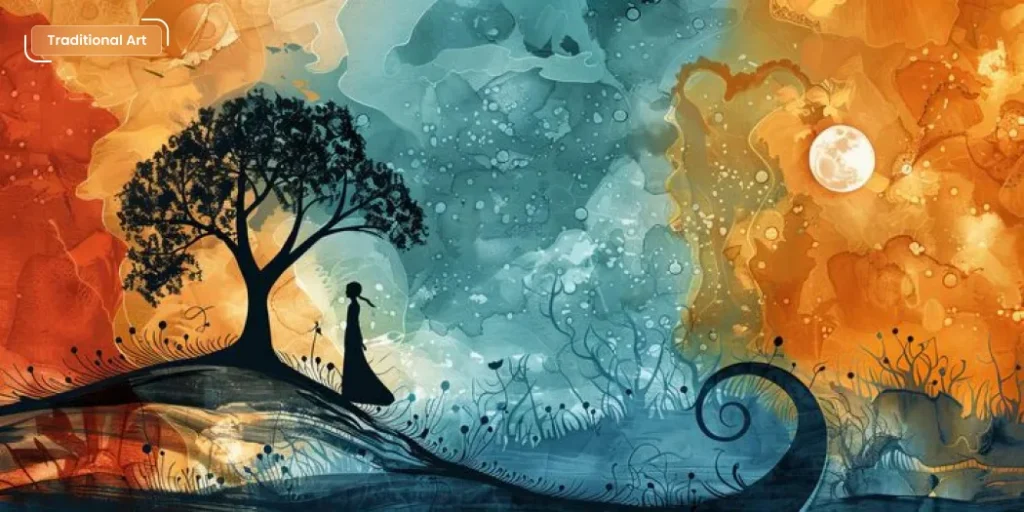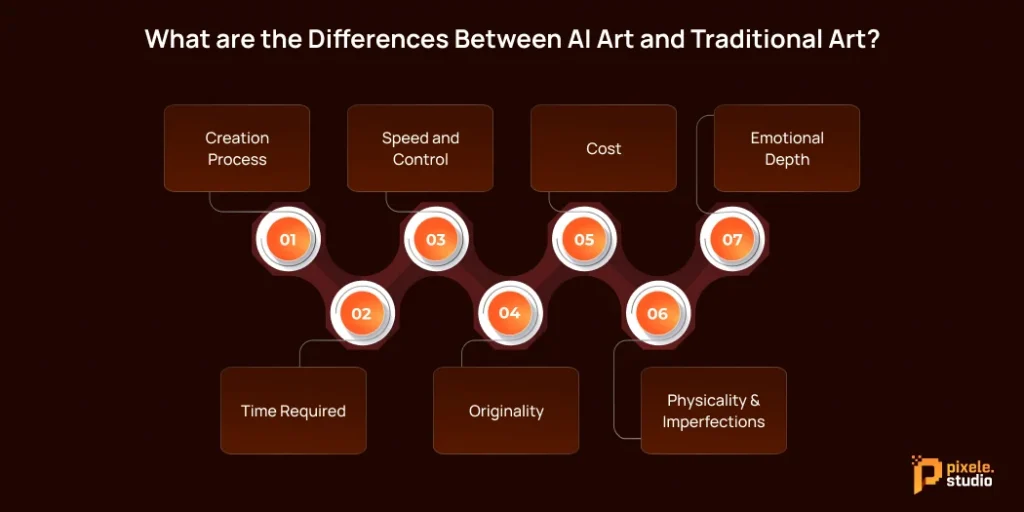Art has always been a reflection of human creativity, evolving with new tools and technologies. Today, the rise of AI art is reshaping how we create, experience, and understand artistic expression.
Traditional art is built on human skill and intuition, and AI art uses advanced algorithms to generate images, offering endless possibilities for innovation. Both forms have unique strengths, and understanding their differences can help artists, designers, and enthusiasts navigate the digital age of creativity.
In this article, we explore the AI art vs traditional art comparison and explain how both styles affect creativity and originality in today’s digital world.
What is AI Art?

AI art is created using artificial intelligence tools that turn text prompts into images. Just enter your idea into the text box, and the AI art generator changes your words into a picture within a few seconds.
AI art is applied to lots of projects, including posters, social media images, a logo, illustrations, creative projects, and personal art. It can be helpful to save time, and makes it possible for anyone, including first-timers, to create attractive visuals.
How it works:
- Generative AI models: These are complex algorithms, such as neural networks, that learn patterns from large datasets of text and images.
- Training: The AI is trained on millions of images with simple text descriptions, so it can easily understand the relationship between a word and a visual concept.
- Prompting: Just type a description of what you want, whether it’s a simple idea or something very detailed.
- Generation: The system uses what it learned to create a new image that matches your prompt.
- Collaboration: You give the idea, and the tool turns it into a picture. It’s a mix of human creativity and machine support.
What is Traditional Art?

Traditional art is created by human hands and requires skill and creativity. It is made using real tools and materials like pencils, paints, brushes, clay, paper, or canvas. Every line, color, and shape is done directly by the artist, which makes each artwork unique.
In traditional styles of making art, the artist does everything themselves. They choose the way it looks, how it feels, the colors, the textures, and every other decision. Because it is handmade, traditional art often carries the artist’s feelings, personal touch, and years of practice.
What are the Differences Between AI Art and Traditional Art?

Creation Process
Traditional art is made by human hand. The artist draws, paints, or sculpts using their own skill, experience, and creativity.
AI art is an artificial intelligence tool that is created by typing an idea into a text box. The AI tool uses what it has learned from many examples to turn your words into an image.
Time Required
Traditional art takes a lot of time because every line, color, and detail is created manually. A single artwork can take hours, days, or even months.
AI art is much faster. The tool can create a complete image in a few seconds because the computer does the heavy work instantly.
Speed and Control
In traditional art, the artist has full control over every step, but it requires patience and skill.
With AI art, the process is quick, but the user has less control over the exact final result. Sometimes the image may not match the idea perfectly, and you need to try again with different prompts.
Originality
Traditional art is one-of-a-kind. No other person can create the same piece in the same way because it comes from the artist’s unique style and emotions.
AI art is based on patterns learned from many images. While the output is new, it is still shaped by the data the AI studied, so the originality depends on the creativity of the prompt and the tool’s training.
Cost
Traditional art can be expensive because it needs materials like paper, canvas, brushes, paint, or clay. Skilled artists also invest years in learning their craft.
AI art is usually cheaper. Many AI art generator tools are affordable pricing, and they don’t require physical materials. You just need a device and an internet connection.
Physicality & Imperfections
Traditional art creates a physical object you can touch, frame, or display. It also has natural imperfections, small details that make the piece feel alive and handmade.
AI art is digital. It is clean, fast, and easy to edit, but it doesn’t have the natural “handmade feel” or texture that traditional art offers.
Emotional Depth
Traditional art often carries deeper emotion because it comes directly from the artist’s hands, experience, and personal expression.
AI art depends on the idea provided by the user. The emotional depth comes from the human prompt, not from the machine itself.
Cost
Traditional art can be expensive because it needs materials like paper, canvas, brushes, paint, or clay. Skilled artists also invest years in learning their craft.
AI art is usually cheaper. Many AI art generator tools are affordable pricing, and they don’t require physical materials. You just need a device and an internet connection.
Physicality & Imperfections
Traditional art creates a physical object you can touch, frame, or display. It also has natural imperfections, small details that make the piece feel alive and handmade.
AI art is digital. It is clean, fast, and easy to edit, but it doesn’t have the natural “handmade feel” or texture that traditional art offers.
Emotional Depth
Traditional art often carries deeper emotion because it comes directly from the artist’s hands, experience, and personal expression.
AI art depends on the idea provided by the user. The emotional depth comes from the human prompt, not from the machine itself.
Simply enter your idea in the text box and create high-quality AI artwork from your text instantly.
AI Art vs Traditional Art – Pros and Cons
Pros of AI Art
- Very fast results: AI tools can create a complete image in just a few seconds. This is useful when you need quick designs, concept art, or fast ideas without spending hours drawing by hand.
- Great for brainstorming: AI is helpful when you’re stuck or need inspiration. You can try different prompts and get many creative options instantly.
- Cost-Effective Solution: Most AI art tools like Pixele Studio are free or affordable. You don’t need to buy paints, brushes, canvases, or other art materials. This makes creating visuals cheaper for beginners, businesses, and content creators.
- Easy for beginners: You don’t need drawing skills to use AI art. Anyone can type their idea, and the tool will create a picture.
- Increased productivity: AI helps you create more artwork in less time. Designers, marketers, and creators can quickly produce multiple versions, try new styles, and finish projects faster without reducing quality.
Cons of AI Art
- Copyright confusion: AI learns from many images, so it’s not always clear who owns the final artwork. This can create copyright and usage concerns.
- No physical artwork: AI art is fully digital. It doesn’t have the real texture, depth, or handmade feel that traditional art provides.
- Less creative control: AI sometimes creates images that don’t fully match your idea. You may need to try different AI image prompt variations to get the result you want.
Pros of Traditional Art
- Completely handmade and original: Traditional art is created by human hands, which makes every piece one-of-a-kind.
- Full creative control: The artist controls every line, color, and detail. Nothing is automated, so the final artwork reflects the artist’s skills, choices, and personal touch.
- Less of a learning curve: Getting started with basic traditional art is simple. Anyone can begin drawing or painting with basic tools and improve naturally over time.
- Lower cost of entry in the short term: You don’t need expensive tools to start. Simple pencils, paper, or basic paints are enough for beginners, making it easy to try traditional art without a big investment.
Cons of Traditional Art
- Can be expensive: As you improve, you may need better tools like high-quality brushes, paints, canvases, or sketchbooks, which can become costly over time.
- Requires skill and practice: Traditional art takes time to master. Artists often spend years improving their technique, control, and style.
- Harder to make edits to the work: Once something is drawn or painted, fixing mistakes can be difficult. Unlike digital art, you can’t undo or easily change major parts of the artwork.
AI vs Traditional Art: Can They Coexist?
Yes, AI art and traditional art can exist together. They are not against each other. They are just two different ways of making art.
Traditional art is made by hand. It shows the artist’s feelings, skills, and personal style. Every piece is unique because it comes directly from the artist.
AI art is created by typing your idea into a tool. It is fast and helpful when you want quick images or want to try many ideas in a short time.
Both can work together. Artists can use AI to get ideas or rough drafts, and then use their hands to create the final artwork. AI can support the artist, not replace them.
In simple words, both AI art and traditional art have their own value. When used together, they can make the creative process even better.
Conclusion
AI art and traditional art both have something to offer to the creative world. Traditional art brings emotion, skill, and a personal touch, while AI art is quick, convenient, and allows for exploring ideas in new ways. Rather than replacing each other, both forms of art can coexist.
For many artists, using AI for quick concept generation, while relying on more traditional means for the final piece, strikes the right balance. In any case, what truly matters is the concept behind the art. In any case, creativity always begins with the mind of human mind.
Frequently Asked Questions
AI art is created using digital tools that turn text prompts into images, while traditional art is made by hand using materials like pencils, paint, or clay.
Yes. AI art is still based on human ideas and creativity. The tool helps generate the image, but the concept and direction come from the user.
AI art is much faster. It can create a full image in seconds, while traditional art may take hours, days, or even months, depending on the detail.
Traditional art is fully handmade, so every piece is unique. AI art is original, too, but it is influenced by the data the tool learned from.
No. AI cannot replace human creativity, emotions, or personal style. Artists use AI as a tool, not a substitute for their skills.
Neither is better. Each has its own strengths. AI is fast and great for quick ideas, while traditional art is personal, emotional, and deeply expressive.
Yes. Many artists use AI to explore ideas before creating final artwork by hand. They complement each other well.
Most AI tools are low-cost or free. Traditional art can get expensive because it requires materials like brushes, canvas, and paints.
AI itself doesn’t feel emotion, but the idea and message come from the human using it. The emotion depends on the creator, not the tool.
Yes, but you should check the tool’s terms and copyright policies, especially if you plan to use the artwork commercially.